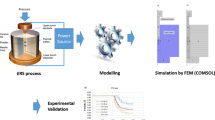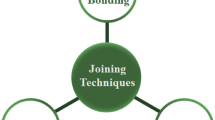Abstract
Microwave (MW) sintering offers higher heating rate, rapid processing, reduced energy consumption, and reduced sintering temperature. However, the technique is not fully understood, difficult to control, and often relies on experience and trial-and-error approach. Consequently, hot spots, uneven heating, thermal runaway, and shape distortion develop in sintered compacts. Therefore, developing a model that can simulate the sintering process, enhance predictability, and determine the critical sintering conditions is essential. Multiphysics finite element (FE) modelling of hybrid MW sintering of a magnesium alloy AZ61 compact was undertaken in this study. The FE model coupled the electromagnetic, heat conduction, and densification equations. The model utilised parameters related to the furnace, compact, and susceptor to predict the spatial distribution of electric field, thermal response, and densification in the compact. A power-based sintering criterion was developed to predict the sintering of the compact and estimate its critical sintering energy. Modelling results showed that heating time, compact size, and thickness of the susceptor are critical to the sintering process. It was also shown that the susceptor not only mediated the sintering of the compact but also homogenised its temperature and densification. Thus, MW sintering of the compact was predicted to occur at 500 °C for 8 to 10 min with a predicted relative density of about 0.98. Experimental MW sintering data showed good concurrence with the developed model. These results are useful for controlling the MW sintering process, eliminating trial-and-error, and determining the critical sintering conditions.












Similar content being viewed by others
References
Blosi M, Albonetti S, Dondi M, Martelli C, Baldi G (2011) Microwave-assisted polyol synthesis of Cu nanoparticles. J Nanopart Res 13:127–138
Kawasaki H, Kosaka Y, Myoujin Y, Narushima T, Yonezawa T, Arakawa R (2011) Microwave-assisted polyol synthesis of copper nanocrystals without using additional protective agents. Chem Commun (Camb) 47:7740–7742. https://doi.org/10.1039/c1cc12346g
Kwak M, Robinson P, Bismarck A, Wise R (2015) Microwave curing of carbon–epoxy composites: penetration depth and material characterisation. Compos Part A Appl Sci Manuf 75:18–27. https://doi.org/10.1016/J.COMPOSITESA.2015.04.007
Xu X, Wang X, Liu W, Zhang X, Li Z, du S (2016) Microwave curing of carbon fiber/bismaleimide composite laminates: material characterization and hot pressing pretreatment. Mater Des 97:316–323. https://doi.org/10.1016/j.matdes.2016.02.093
Mishra P, Sethi G, Upadhyaya A (2006) Modeling of microwave heating of particulate metals. Metall Mater Trans B Process Metall Mater Process Sci 37:839–845. https://doi.org/10.1007/s11663-006-0066-z
Riedel H, Svoboda J (2006) Simulation of microwave sintering with advanced sintering models. In: Willert-Porada M (ed) Advances in microwave and radio frequency processing. Springer-Verlag, Berlin, pp 210–216
Manière C, Zahrah T, Olevsky EA (2017) Fully coupled electromagnetic-thermal-mechanical comparative simulation of direct vs hybrid microwave sintering of 3Y-ZrO2. J Am Ceram Soc 100:2439–2450. https://doi.org/10.1111/jace.14762
Roy R, Agrawal D, Cheng J, Gedevanishvili S (1999) Full sintering of powdered-metal bodies in a microwave field. Nature 401:668–670
Mishra RR, Sharma AK (2016) Microwave-material interaction phenomena: heating mechanisms, challenges and opportunities in material processing. Compos Part A Appl Sci Manuf 81:78–97
Oghbaei M, Mirzaee O (2010) Microwave versus conventional sintering: a review of fundamentals, advantages and applications. J Alloys Compd 494:175–189. https://doi.org/10.1016/j.jallcom.2010.01.068
Akinwekomi AD, Law W-C, Tang C-Y, Chen L, Tsui CP (2016) Rapid microwave sintering of carbon nanotube-filled AZ61 magnesium alloy composites. Compos Part B Eng 93:302–309. https://doi.org/10.1016/j.compositesb.2016.03.041
Akinwekomi AD, Law W-C, Choy M-T, Chen L, Tang CY, Tsui GCP, Yang XS (2018) Processing and characterisation of carbon nanotube-reinforced magnesium alloy composite foams by rapid microwave sintering. Mater Sci Eng A 726:82–92. https://doi.org/10.1016/j.msea.2018.04.069
Mishra RR, Sharma AK (2016) On mechanism of in-situ microwave casting of aluminium alloy 7039 and cast microstructure. Mater Des 112:97–106. https://doi.org/10.1016/J.MATDES.2016.09.041
Mishra RR, Sharma AK (2017) Effect of susceptor and mold material on microstructure of in-situ microwave casts of Al-Zn-Mg alloy. Mater Des 131:428–440. https://doi.org/10.1016/j.matdes.2017.06.038
Babu A, Arora HS, Behera SN, Sharma M, Grewal HS (2018) Towards highly durable bimodal composite claddings using microwave processing. Surf Coatings Technol 349:655–666. https://doi.org/10.1016/j.surfcoat.2018.06.059
Tang CY, Zhang LN, Wong CT, Chan KC, Yue TM (2011) Fabrication and characteristics of porous NiTi shape memory alloy synthesized by microwave sintering. Mater Sci Eng A 528:6006–6011. https://doi.org/10.1016/j.msea.2011.04.040
Tamang S, Potaliya P, Aravindan S (2017) Corrosion behaviour of magnesium–yttria composite sintered by microwave hybrid heating. Mater Res Innov 22:422–426. https://doi.org/10.1080/14328917.2017.1337297
Rybakov KI, Olevsky EA, Krikun EV (2013) Microwave sintering: fundamentals and modeling. J Am Ceram Soc 96:1003–1020. https://doi.org/10.1111/jace.12278
Demirskyi D, Agrawal D, Ragulya A (2013) Tough ceramics by microwave sintering of nanocrystalline titanium diboride ceramics. Ceram Int 40:1–8. https://doi.org/10.1016/j.ceramint.2013.07.010
Akinwekomi AD, Choy MT, Law WC, Tang CY (2016) Finite element modelling of CNT-filled magnesium alloy matrix composites under microwave irradiation. Mater Sci Forum 867:83–87. https://doi.org/10.4028/www.scientific.net/MSF.867.83
Santos T, Valente MA, Monteiro J, Sousa J, Costa LC (2011) Electromagnetic and thermal history during microwave heating. Appl Therm Eng 31:3255–3261. https://doi.org/10.1016/j.applthermaleng.2011.06.006
Buchelnikov VD, Louzguine-Luzgin DV, Xie G, Li S, Yoshikawa N, Sato M, Anzulevich AP, Bychkov IV, Inoue A (2008) Heating of metallic powders by microwaves: experiment and theory. J Appl Phys 104:113505. https://doi.org/10.1063/1.3009677
Rybakov KI, Semenov VE, Egorov SV, Eremeev AG, Plotnikov IV, Bykov YV (2006) Microwave heating of conductive powder materials. J Appl Phys 99:023506–023509. https://doi.org/10.1063/1.2159078
Bouvard D, Charmond S, Carry CP (2010) Finite element modelling of microwave sintering. In: Bordia RK, Olevsky EA (eds) Advances in Sintering Science and Technology. Wiley, Inc., Hoboken, pp 171–180
Shukla AK, Mondal A, Upadhyaya A (2010) Numerical modeling of microwave heating. Sci Sinter 42:99–124. https://doi.org/10.2298/SOS1001099S
Iskander MF, Smith RL, Andrade AOM, Kimrey H, Wal LM (1994) FDTD simulation of microwave sintering of ceramics in multimode cavities. IEEE Trans Microw Theory Tech 42:793–800. https://doi.org/10.1109/22.293527
Ignatenko M, Tanaka M (2010) Effective permittivity and permeability of coated metal powders at microwave frequency. Phys B Condens Matter 405:352–358. https://doi.org/10.1016/j.physb.2009.08.086
Maxim I, Tanaka M (2011) Numerical analysis of the microwave heating of compacted copper powders in single-mode cavity. Jpn J Appl Phys 50. https://doi.org/10.1143/JJAP.50.097302
Birnboim A, Carmel Y (1999) Simulation of microwave sintering of ceramic bodies with complex geometry. J Am Ceram Soc 82:3024–3030. https://doi.org/10.1109/PLASMA.1999.829397
Ma J, Diehl JF, Johnson EJ, Martin KR, Miskovsky NM, Smith CT, Weisel GJ, Weiss BL, Zimmerman DT (2007) Systematic study of microwave absorption, heating, and microstructure evolution of porous copper powder metal compacts. J Appl Phys 101:074906. https://doi.org/10.1063/1.2713087
Thostenson ET, Chou T-W (1999) Microwave processing: fundamentals and applications. Compos Part A Appl Sci Manuf 30:1055–1071. https://doi.org/10.1016/S1359-835X(99)00020-2
Haque KE (1999) Microwave energy for mineral treatment processes—a brief review. Int J Miner Process 57:1–24. https://doi.org/10.1016/S0301-7516(99)00009-5
Walkiewicz JW, Kazonich G, McGill SL (1988) Microwave heating characteristics of selected minerals and compounds. Miner Metall Process 5:39–42
Akinwekomi AD, Tang C, Tsui GC et al (2018) Synthesis and characterisation of floatable magnesium alloy syntactic foams with hybridised cell morphology. Mater Des 160:591–600. https://doi.org/10.1016/j.matdes.2018.10.004
Duan Y, Sorescu DC, Johnson JK (2006) Finite element approach to microwave sintering of oxide materials. In: Proceedings of the COMSOL Conference. COMSOL, Boston, pp 2–7
Lasri J, Ramesh PD, Schächter L (2000) Energy conversion during microwave sintering of a multiphase ceramic surrounded by a susceptor. J Am Ceram Soc 83:1465–1468. https://doi.org/10.1111/j.1151-2916.2000.tb01411.x
German RM (1996) Sintering theory and practice. Wiley, New York
COMSOL Inc (2016) COMSOL Multiphysics® Modeling Software
Zhang L, Zhu H (2009) Dielectric, magnetic, and microwave absorbing properties of multi-walled carbon nanotubes filled with Sm2O3 nanoparticles. Mater Lett 63:272–274. https://doi.org/10.1016/j.matlet.2008.10.015
Gupta M, Wong WLE (2007) Microwaves and metals. Wiley (Asia) Pte Ltd., Singapore
Friedrich HE, Mordike BL (2006) Magnesium technology: metallurgy, design data, applications. Springer-Verlag, Berlin
Lee S, Ham HJ, Kwon SY, Kim SW, Suh CM (2013) Thermal conductivity of magnesium alloys in the temperature range from −125 °C to 400 °C. Int J Thermophys 34:2343–2350. https://doi.org/10.1007/s10765-011-1145-1
ASM International (2002) ASM ready reference: thermal properties of metals. ASM International
Avedesian MM, Baker H (1999) ASM specialty handbook: magnesium and magnesium alloys. ASM International
Optotherm Emissivity Table. http://www.optotherm.com/emiss-table.htm. Accessed 21 Jun 2016
Wong WLE, Gupta M (2007) Development of Mg/Cu nanocomposites using microwave assisted rapid sintering. Compos Sci Technol 67:1541–1552. https://doi.org/10.1016/j.compscitech.2006.07.015
Gupta M, Sharon NML (2011) Magnesium, magnesium alloys, and magnesium composites. Wiley, Inc., Hoboken
Čapek J, Vojtěch D (2014) Effect of sintering conditions on the microstructural and mechanical characteristics of porous magnesium materials prepared by powder metallurgy. Mater Sci Eng C 35:21–28. https://doi.org/10.1016/j.msec.2013.10.014
Funding
This study was supported by both the Research Committee of the Hong Kong Polytechnic University (student account code: RK20) and the Hong Kong PhD Fellowship Scheme (Project Code: 1-904Z).
Author information
Authors and Affiliations
Corresponding author
Additional information
Publisher’s note
Springer Nature remains neutral with regard to jurisdictional claims in published maps and institutional affiliations.
Rights and permissions
About this article
Cite this article
Akinwekomi, A.D., Yeung, KW., Tang, CY. et al. Finite element simulation of hybrid microwave sintering based on power approach. Int J Adv Manuf Technol 110, 2503–2515 (2020). https://doi.org/10.1007/s00170-020-05952-0
Received:
Accepted:
Published:
Issue Date:
DOI: https://doi.org/10.1007/s00170-020-05952-0




